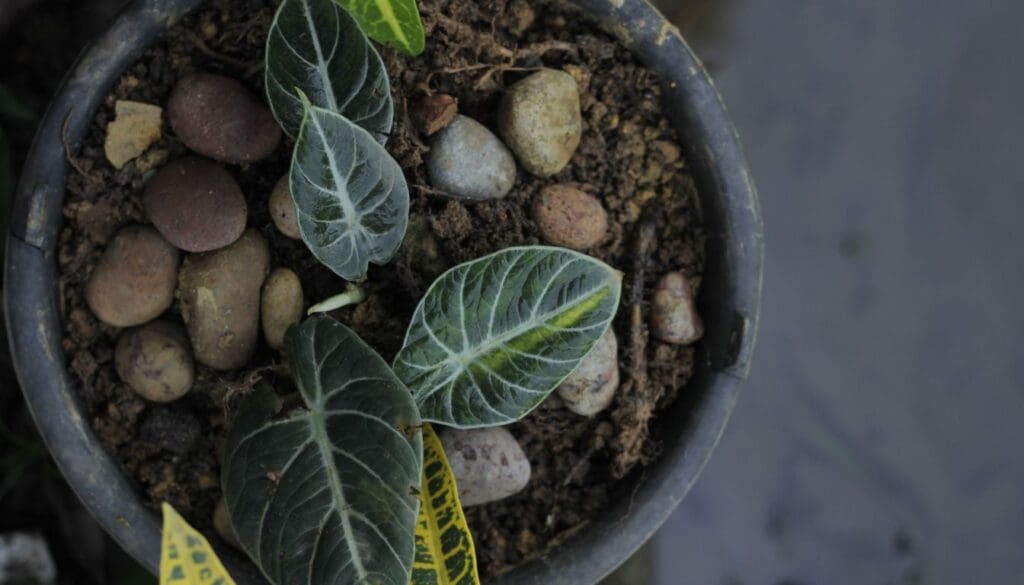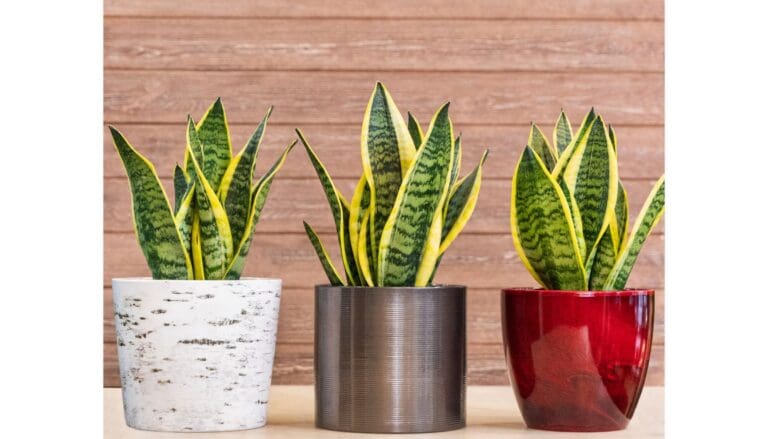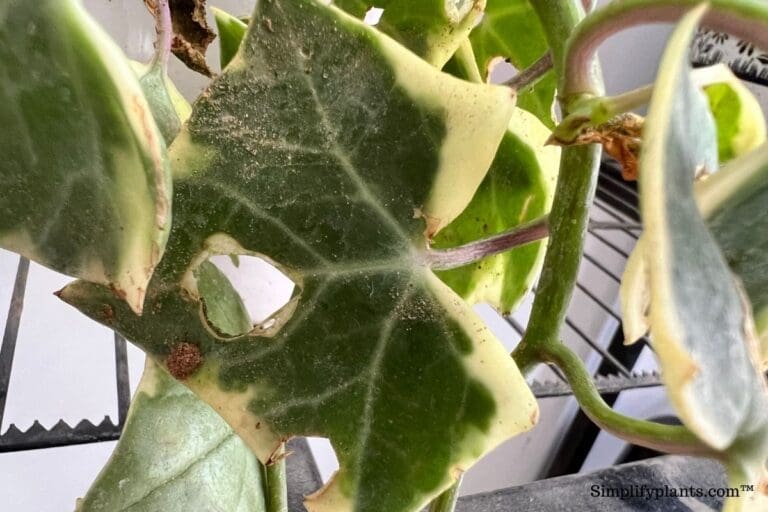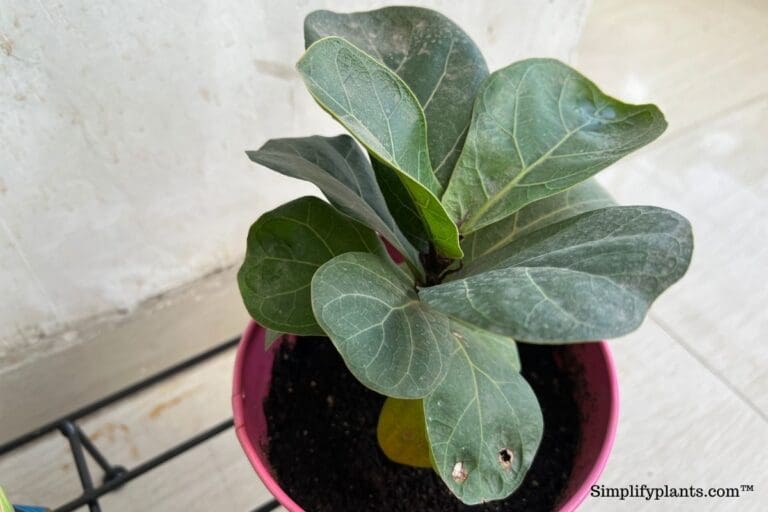Alocasia Leaves Drooping? 9 Causes & Easy Fix
Alocasia is a popular houseplant known for its large and exotic foliage. But seeing these beautiful plants droop is disheartening. If you’re wondering why your alocasia is drooping, I am here to help.
The possible reasons that cause your alocasia to droop are overwatering, underwatering, lighting problems, temperature stress, low humidity levels, transplant shock, and pest infestations. You can help your plant recover by correcting the underlying cause and providing proper care.
In this article, I will discuss the various reasons that cause your alocasia to droop and provide some helpful information to identify and fix the problem.

Please note: Simplify Plants is reader-supported. Some links in the post are affiliate links and I get a commission from purchases made through links in the post.
Why is my alocasia drooping?
Droopy leaves on your alocasia indicate some problems.
Alocasia being fussy, will droop if they get improper care and unfriendly growing conditions.
If you notice any signs of droopy leaves, try to figure out the exact reason and fix it before it’s too late.
Here are all the possible reasons for droopy leaves on your alocasia.
- Underwatering
- Overwatering
- Inappropriate lightening
- Overfertilization
- Lack of nutrients
- Low humidity level
- Temperature stress
- Transplant shock
- Pest infestations
Now, let’s discuss all the above points.
1) Underwatering can make your alocasia leaves droopy
Alocasia prefers to grow in moist soil, and the leaves will droop if you allow the soil to dry out completely.
Underwatering will cause their leaves to wilt and turn brown.
The plant will lose its turgidity due to the absence of moisture and will become weak and unstable.
Signs of underwatering:
- Dry soil: If you underwater your alocasia, the soil in the pot will remain dry within a few days of watering.
- Brown crispy edges: If you notice the leaf edges turning dry and crispy, it indicates that your alocasia is underwatered. This occurs when moisture fails to reach the extreme leaf edges.
- Rootbound plant: If you keep your alocasia in a small pot, the plant will get rootbound. They will dry out faster, thus creating an underwatering situation.
How to fix underwatering?
If your alocasia is experiencing an underwatering issue, you can give it a thorough soak of water.
- You can fill a bathtub with 3-4 inches of water for this.
- Take the plant out of the pot.
- Then, place your alocasia in the tub and allow it to soak in water for at least 30-45 minutes.
- Once the topsoil is saturated, remove the plant from the tub and keep it in a sunny spot.
Monitor your plant regularly and prepare a consistent watering schedule for your plant.
Water the plant whenever the top 2 inches of the soil feels dry, and don’t keep it thirsty for too long.
You can check the moisture with a moisture meter.
Keep the environment around the plant humid so that your plant stays moist and hydrated.
2) Your alocasia leaves are drooping because of Overwatering

Overwatering is a common reason for Alocasia drooping.
It is more serious than underwatering, and its consequences are hard to recover.
Overwatering issues can occur due to several factors, such as poor-drained soil, a pot with no drainage holes, insufficient lighting, dormant season, etc.
Overwatering will cause your plant’s soil to remain soggy and waterlogged for longer.
This condition will prevent air circulation in the soil as the air spaces will get filled with water.
Lack of oxygen in the soil will suffocate the root system, causing the roots to fail to breathe and function properly.
Prolonged soggy conditions can result in root rot that completely damages the roots.
Such roots will fail to transfer water and nutrients to the plant, so they will droop.
Also read: Overwatering vs. Underwatering your plants.
Signs of overwatering:
- Soggy soil: If the soil in the pot remains wet for more than 7 days after watering, your plant is at high risk of overwatering.
- Yellow leaves: If you notice the bottom leaves of your plant turning yellow, it’s an early sign of overwatering.
- Leaf Edema: If your Alocasia shows watery blisters on its leaf surfaces, it’s a sign of an overwatered plant. Since the plant cannot hold too much water, it blisters the leaves.
- Brown spots: You will notice moist brown spots on the leaf surfaces of your plant due to overwatering.
- Rotting smell: Overwatering can result in root rot, so you may get a rotting smell from the base of the plant.
How to fix overwatering?
If your alocasia is experiencing an overwatering issue:
- You should stop watering the plant immediately.
- Keep the pot in a sunny spot until the soil dries.
- Also, add ventilation if needed.
- If the plant is not recovering, go for repotting.
- Take out the plant from the pot and check for root rot.
- If you find mushy and decaying roots, remove them, spray fungicide on the healthy ones, and repot the plant in a new container and new potting mix.
- Wait for the plant to recover and water only when the soil is ready for it.
To prevent overwatering:
- Check the soil surface each time before you water.
- You should water the alocasia only when the first few inches of the soil become dry.
- Also, plant your alocasia in a pot with drainage holes to prevent waterlogging.
- If the pot is too big, it will contain more water and soil, increasing the chances of overwatering. Therefore, use a pot that is 1-2 inches bigger than the plant.
- If the potting soil is heavy, add perlite or pumice to improve drainage.
Also read: How To Water Alocasia Plant? (How Much, How Often & More)
3) Inappropriate lighting can lead to droopy alocasia leaves.

Alocasia prefers bright, indirect sunlight for growth.
They will get droopy if you place them in a dark spot.
The low light condition will slow down their growth rate, reduce their watering requirements, and increase the chances of overwatering.
Low light will not allow the plant to perform the process of photosynthesis, due to which they will not get the required energy to carry out the life processes.
The leaves of your plant will fade and droop due to poor light.
Too much light can also cause your alocasia to develop droopy leaves.
Direct or excess light can dehydrate the plant due to increased transpiration.
Also read: What Kind Of Light Does Alocasia Need? Alocasia Light Requirements
Where should I place my Alocasia plant?
To prevent drooping, choose a location that will provide your alocasia with bright, indirect light.
The best location for alocasia will be an East or North-facing window, as it will provide them with the light they need for growth.
Keep the plant away from direct sunlight as their leaves are delicate and can get sunburned.
You can keep the plant a few feet away from the window or put on the curtains on the window to prevent direct sunlight.
4) Overfertilization can make your alocasia droopy.
Alocasia needs adequate feeding to grow and thrive, but overdoing it can cause severe damage to the plant.
Overfertilization will burn their root system, due to which the roots will weaken and will fail to function properly.
The roots will not provide essential nutrients and water to the plant, so it will not get the energy to grow and will droop.
You may notice brown spots on their foliage if you over-fertilize your alocasia.
If your alocasia is drooping due to overfertilization, you must remove the damaged foliage and burned roots and repot it with a fresh potting mix if the damage is heavy.
If the damage is minor or in the initial stages, you can take the plant to the sink and run water over the soil 3-4 times to remove the salt build-up from the soil.
5) Under fertilization can lead to droopy leaves in alocasia.
Alocasia is a heavy feeder which needs proper fertilization for growth.
The soil alone cannot provide all the required nutrients to the plant as it loses its nutrients over time.
If you don’t fertilize your alocasia during the growing season, it will not get the strength to grow and become droopy.
What fertilizer is best for my Alocasia plant?

You should use a balanced fertilizer for feeding your Alocasia plant.
The fertilizers should have balanced amounts of Nitrogen, Potassium, and phosphorus.
Feed your plant with a liquid fertilizer in NPK ratio 20:20:20 once or twice in a month.
Fertilize the plant in the summer and spring seasons, as these are their active growing season.
Avoid fertilizing them in winter as the plant will go dormant during this season and not show growth.
Also read: What Fertilizer To Use For Alocasia? (Ideal Fertilizer+Dosage Guide)
6) Low humidity levels can lead to droopy leaves.
Alocasia is a tropical plant that needs a humid environment for growth.
They cannot tolerate dry conditions and will be displeased if humidity levels fall below 40%.
Lack of humidity will cause your plant’s leaves to droop, curl, and get brown tips and edges.
Low humidity will cause your alocasia to transpire at an increased rate.
As a result, their leaves will dry out faster.
In such conditions, the plant will not supply water from the roots as fast enough to replace the loss through the leaves, resulting in leaf drooping.
The plant’s growth will get hampered, and it will look more droopy and pale due to lack of humidity.
How can I raise the humidity of my alocasia?
You can raise the humidity for your alocasia in the following ways:
- You can mist the leaves of your alocasia frequently with a spray bottle. Although this is not a practical solution, it will raise the humidity for a while.
- You can increase the humidity level around the alocasia by using a humidifier.
- You can group your alocasia with other houseplants to raise the moisture level by the effect of transpiration in the environment.
- You can place your alocasia on a tray filled with pebbles and water. The water will evaporate from the tray and add humidity to the surrounding air.
Also read: Should I Mist My Alocasia? (Ideal Humidity+How To Maintain)
7) Temperature stress can make your alocasia droopy.
Alocasias are tropical plants that enjoy warm temperatures between 65-85°F.
Improper temperatures will make them unhealthy, and their leaves will turn sickly and droopy.
Both hot and cold temperatures can cause droopy leaves as they will not adjust to their ideal range.
They do not react well to hot or cold drafts and, therefore, will get droopy leaves if you place them near heating or cooling vents or close to a window.
Alocasia plants are sensitive to low temperatures, so they need more protection during winter.
To protect the plant, keep it away from frosty windows and doors.
Keep your alocasia in a location where it will get bright sunlight.
You can also use a thermostat device to adjust the temperature of your plant.
8) Transplant shock often leads to droopy alocasia.

Alocasias will get transplant shock and droop when you repot it.
Also, your plant can get stressed when you repot it at the wrong time.
Many plants get transplant shock when they are placed in a new pot.
This happens because their root gets disturbed in the repotting process.
The plant will show symptoms like yellowing, dropping leaves, and wilting.
If your plant experiences a transplant shock, prune off the dead and damaged leaves to encourage new growth.
How should I prevent transplant shock on my alocasia?
You can’t prevent a transplantation shock entirely, but you can reduce it if you do it the right way.
- Be careful while repotting so that roots don’t get damaged.
- The new potting mix should be similar to the old one. An entire change in the potting mix will severely affect the plant.
- Water your alocasia adequately to reduce the transplant shock.
Also read: When Do You Repot Alocasia Plant? (Ideal Time+How To)
9) Pest infestations are a primary cause of droopy alocasia leaves.
Alocasias are sensitive plants that might get attacked by sap-sucking insects.
Pests such as mealybugs, aphids, and scales can put your plant in trouble.
Pests will suck out moisture and nutrients from the leaves and make the plant droopy due to weakness.
How should I treat pests on my alocasia?
To prevent pest infests on your alocasia, follow the preventive measures given below:
- You should inspect your plant to check for any pest infestation when you notice droopy leaves.
- If you find pests, use Neem oil or insecticidal soap to remove them.
- You can also wipe your plant’s leaves by dipping cotton balls in an alcohol solution to remove the pests.
- You can also use pesticides and insecticides to treat pests. Read the label and application instructions carefully before using them.
Also read: How Do I Get Rid Of Bugs In Alocasia? (+Common Bugs Identification)
Should I cut off drooping alocasia leaves?

I suggest that you prune off the droopy leaves from your alocasia plant.
Droopy leaves are useless to the plant, and pruning them off will encourage new growth.
The leaves will themselves fall from the plant, but you can prune them if you want.
Whenever you prune, trim the leaves as close to the base of the plant.
Always use a sharp and sterilized pair of pruners for pruning the plant.
However, if the leaves are drooping due to underwatering or under fertilization, avoid pruning as they might return to health after the right treatment.
Also read: Where To Prune Alocasia? (Best Time+How To)
How will I prevent the drooping of my alocasia?
We have already discussed the possible causes of the drooping of your alocasia.
Let us now look at these basic care requirements to prevent your alocasia from drooping.
| Factor | Care Requirements |
|---|---|
| Light | Provide your alocasia with bright, indirect sunlight and keep them away from direct sunlight. Rotate your alocasia every week so that all of its sides receive an equal amount of light. Use artificial lights if it is not getting enough light. |
| Soil | Provide your alocasia with bright, indirect sunlight and keep them away from direct sunlight. Rotate your alocasia every week so that all of its sides receive an equal amount of light. Use artificial lights if it is not getting enough light. |
| Watering | Always check the moisture level of the soil before watering the plant. |
| Fertilization | Use a balanced liquid fertilizer for feeding your plant. You can dilute the fertilizer with water to avoid over-fertilization. |
| Temperature | Provide your alocasia with bright, indirect sunlight and keep them away from direct sunlight. Rotate your alocasia every week so that all of its sides receive an equal amount of light. Use artificial lights if it is not getting enough light. |
| Humidity | Provide your Alocasia with bright, indirect sunlight and keep them away from direct sunlight. Rotate your alocasia every week so that all of its sides receive an equal amount of light. Use artificial lights if it is not getting enough light. |
| Pruning | Regularly prune your plant’s damaged and dead leaves to encourage new and healthy growth. |
| Repotting | Dust the leaves frequently so that they can photosynthesize better. While dusting, check the underside of the leaves to keep an eye on the pests. You can mist the leaves frequently to raise humidity and keep the leaves clean and dust-free. |
| Winter care | During winters, reduce watering and fertilization as it is their dormant season. |
| Cleaning | Dust the leaves frequently so that they can photosynthesize better. While dusting, check the underside of the leaves to keep an eye over the pests. You can mist the leaves frequently to raise humidity and keep the leaves clean and dust-free. |
| Prevent pests | Spray Neem oil solution or horticulture oil on their leaves every month to keep pests away. |

Reference: Alocasia sanderiana, Alocasia micholitziana.
Recommended Garden Supplies
| Product Image | Our Recommended Gardening Supplies | Check Offers! |
|---|---|---|
Top Top
Top
Top
Top
Top
Top
Top
Top | rePotme Houseplant and Tropical Classic Potting Soil Mix | Check Offer On Amazon |
 Top
Top
Top
Top
Top
Top
Top
Top | Espoma Organic Indoor Plant Food | Check Offer On Amazon |
 Top
Top
Top
Top
Top
Top
Top
Top | GooingTop LED Grow Light 6000K Full Spectrum Clip Plant Growing Lamp | Check Offer On Amazon |
 Top
Top
Top
Top
Top
Top
Top
Top | Soil Moisture Meter | Check Offer On Amazon |
 Top
Top
Top
Top
Top
Top
Top
Top | Govee Hygrometer Thermometer, Bluetooth Enabled! | Check Offer On Amazon |
 Top
Top | LEVOIT Humidifiers for Large Room(Best For Plants) | Check Offer On Amazon |
 Top
Top
Top
Top
Top
Top
Top
Top | Upgraded DIY Automatic Drip Irrigation Kit, 15 Potted Houseplants Support | Check Offer On Amazon |
 Top
Top
Top
Top
Top
Top
Top
Top | Stainless Steel Heavy Duty Gardening Tool Set | Check Offer On Amazon |
 Top
Top
Top
Top
Top
Top
Top
Top | Bonide Insecticidal Soap | Check Offer On Amazon |
 Top
Top
Top
Top
Top
Top
Top
Top | Bonide 32 oz Spray Neem Oil for Organic Gardening | Check Offer On Amazon |
 Top
Top
Top
Top
Top
Top
Top
Top | Garden Safe Fungicide | Check Offer On Amazon |






